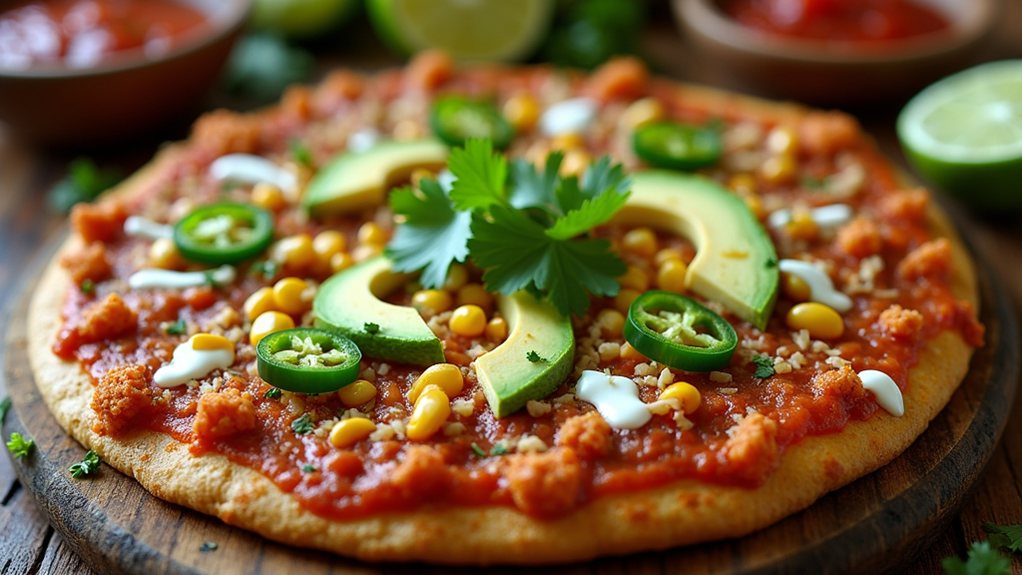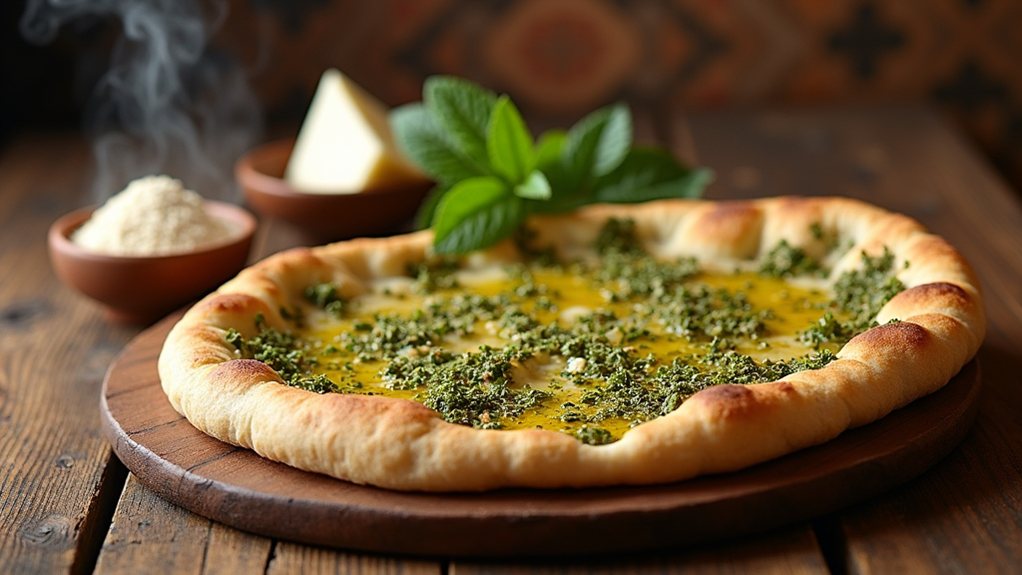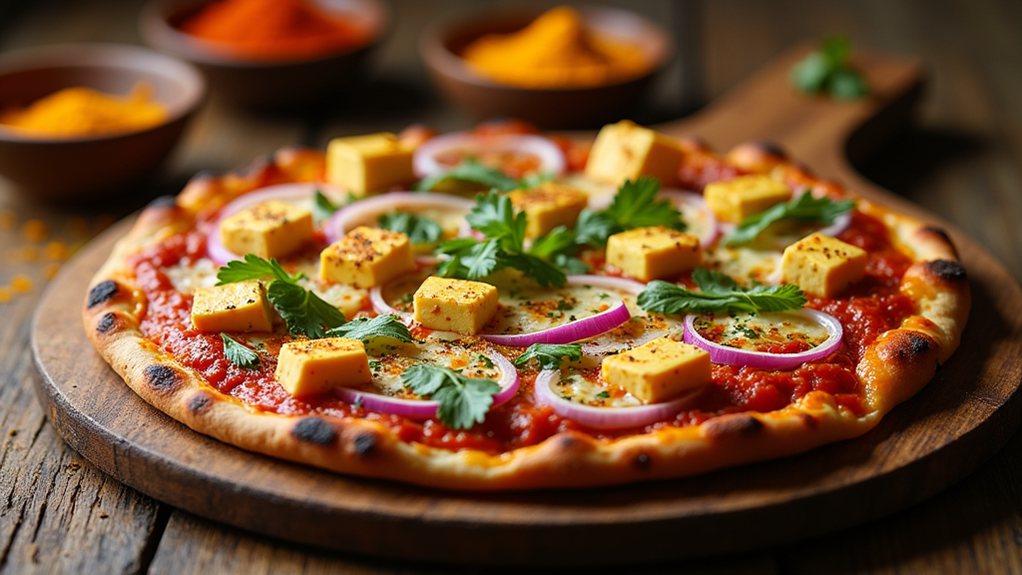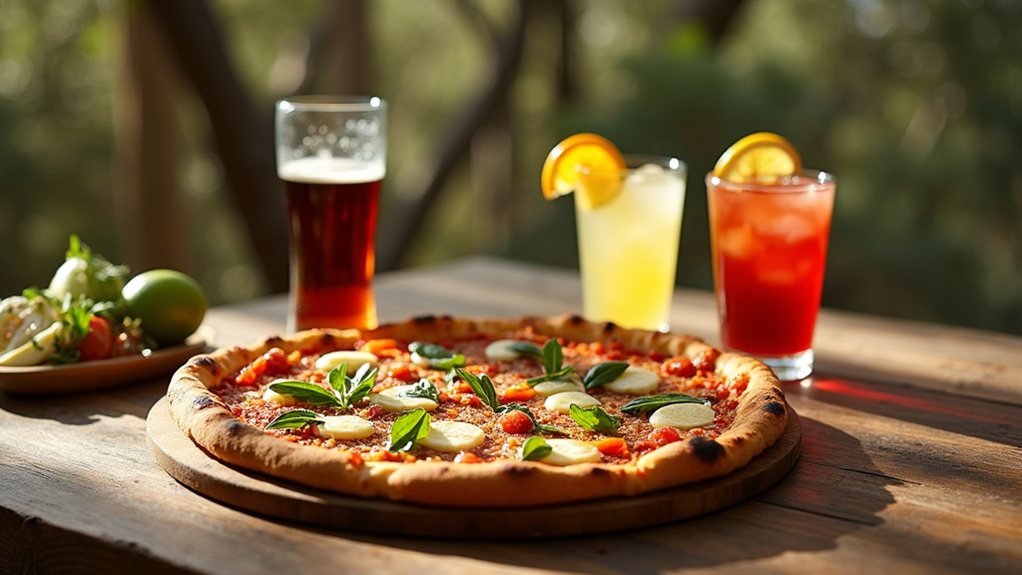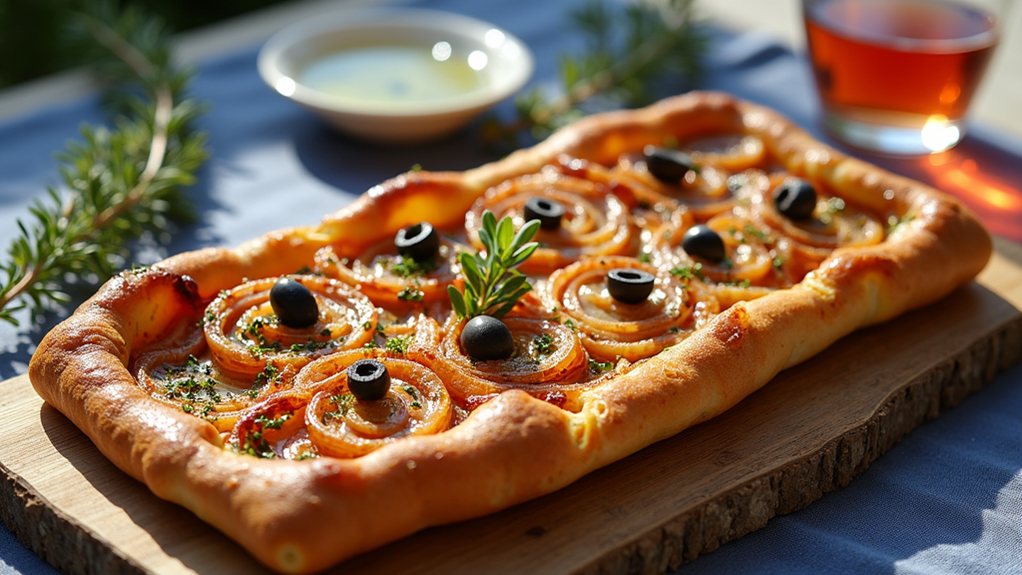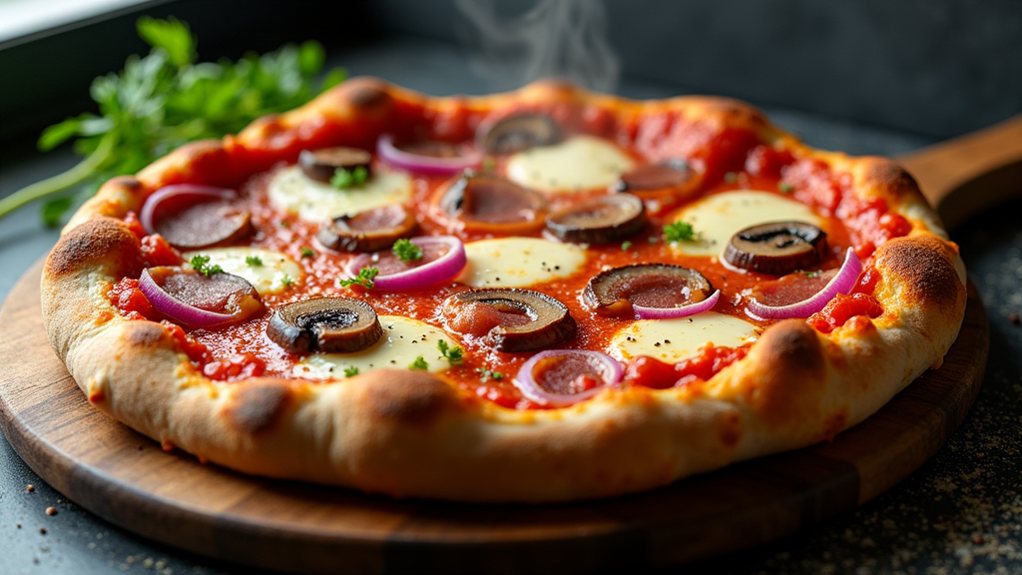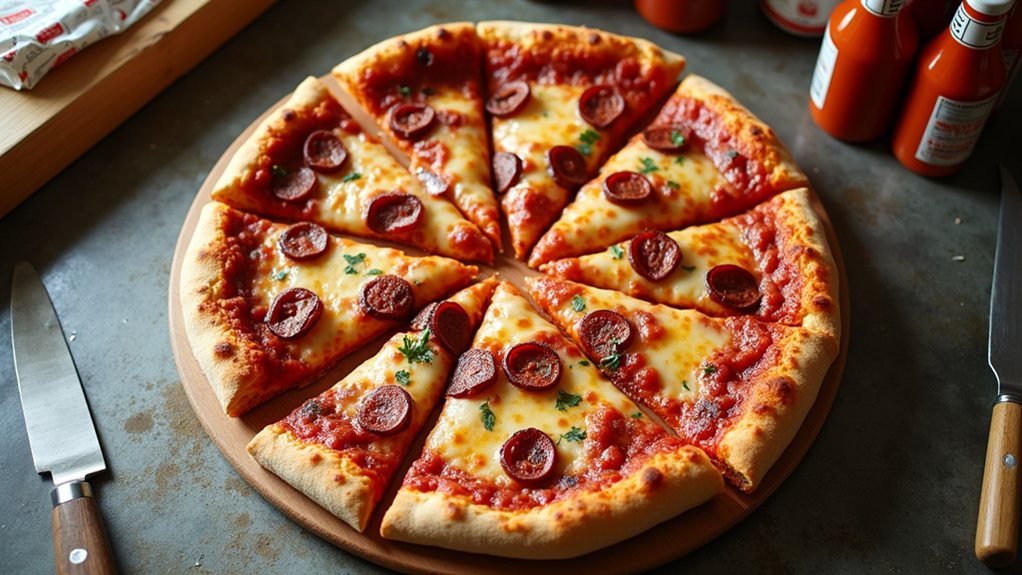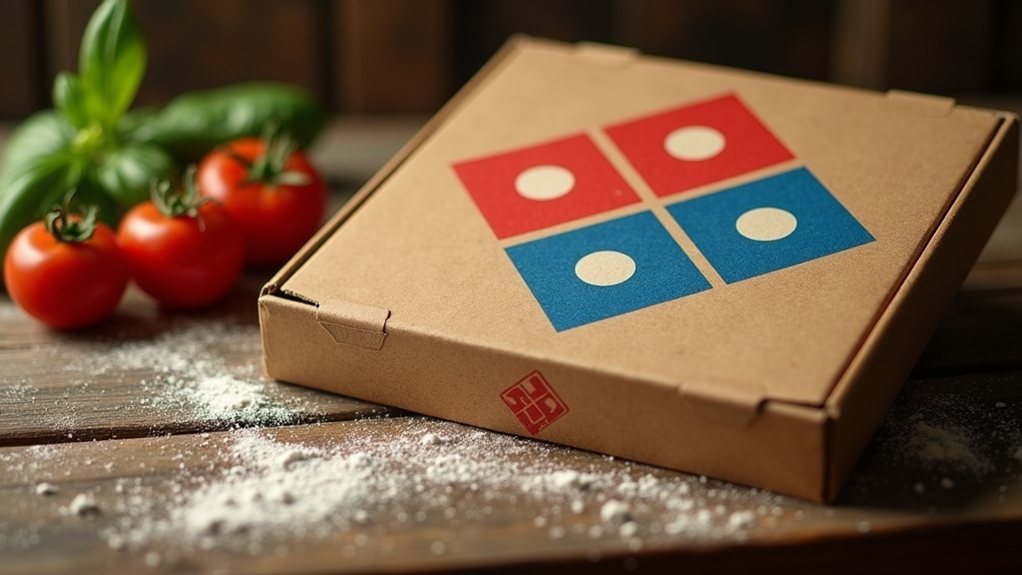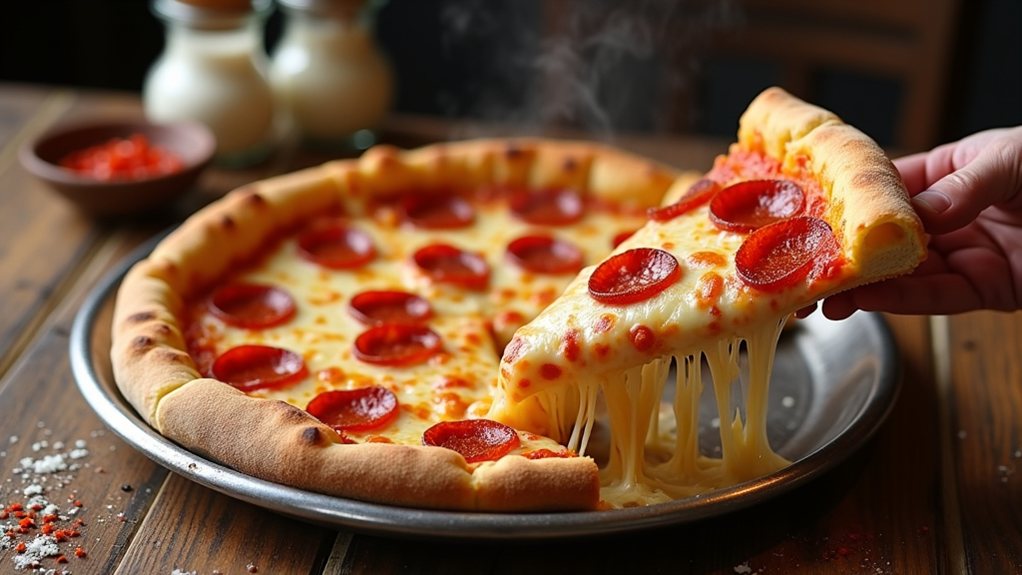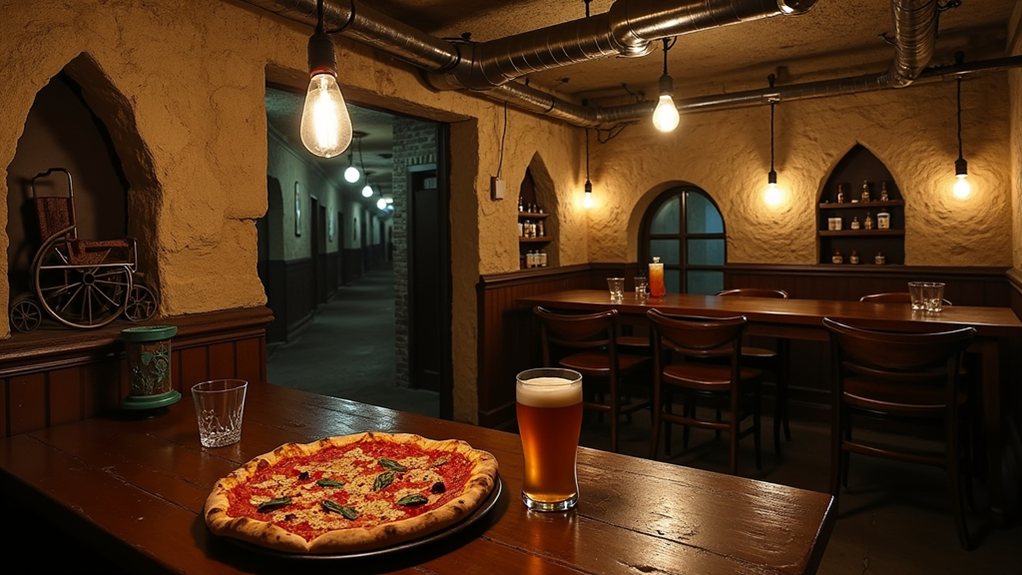Mexican pizza transforms traditional Italian fare with a distinctive south-of-the-border flair. The dish combines crispy tortillas with seasoned beef, refried beans, and zesty enchilada sauce, creating a fusion experience that satisfies diverse cravings. Toppings like jalapeños provide customizable heat, while fresh tomatoes and cilantro offer cooling contrast. This culinary hybrid has evolved beyond fast-food origins to become a versatile favorite in home kitchens, where creative cooks continue to explore with authentic ingredients and innovative variations.
The Origin Story: How Mexican Pizza Became a Favorite Fusion Dish
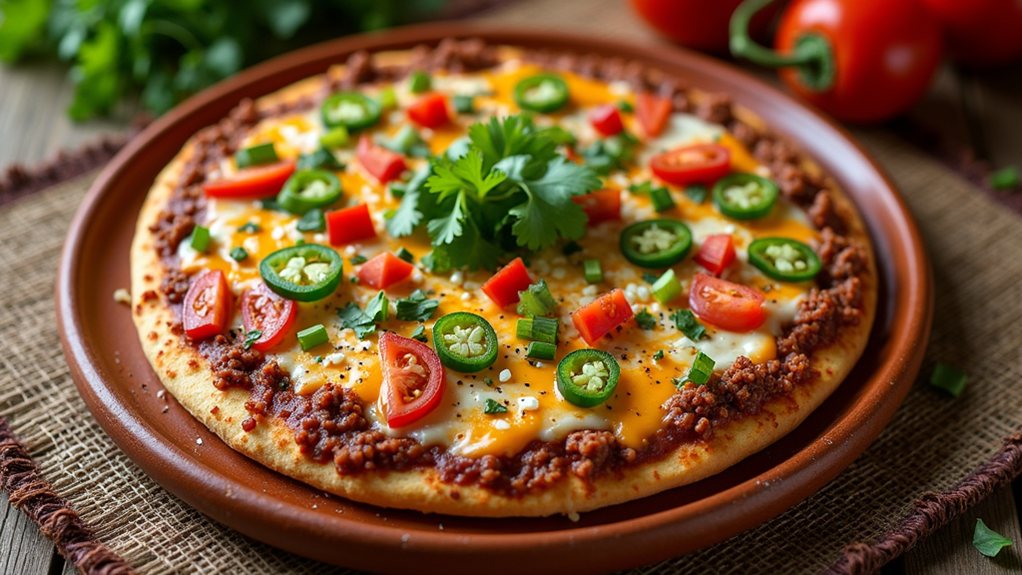
Fusion cuisine found a perfect ambassador in the Mexican Pizza, which began its voyage on Taco Bell's menu in 1985 under the name "Pizzazz Pizza." This innovative creation combined classic Mexican ingredients, including seasoned beef, refried beans, and cheese, with the familiar format of Italian pizza, creating a cross-cultural culinary experience that would eventually gain cult status.
In 1988, the item was officially renamed "Mexican Pizza," solidifying its identity as a unique menu offering. The original recipe featured distinctive toppings like olives and onions that were later modified to create the version fans came to love. Today's health-conscious food enthusiasts can enjoy a guilt-free version by substituting regular cheese with low-fat alternatives. The expedition wasn't without challenges, however, as a Cleveland-area pizzeria filed a lawsuit for trademark infringement shortly after its introduction.
Despite this rocky start, the dish developed a devoted following, particularly among South Asian Americans who appreciated its vegetarian adaptability, making it one of Taco Bell's most distinctive and cherished menu items.
Essential Ingredients for Authentic Mexican Pizza Flavor
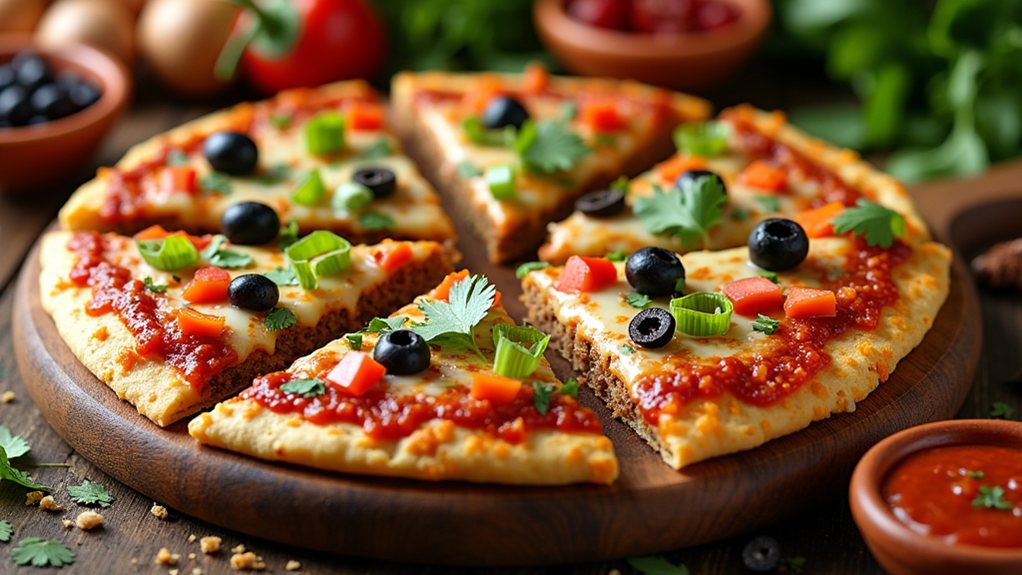
While creating an authentic Mexican Pizza experience requires attention to key components, the foundation begins with a careful selection of ingredients that balance traditional Mexican flavors with the structural elements of a pizza.
Flour or corn tortillas serve as the crispy base, traditionally layered with refried beans that provide a creamy foundation for the protein layer.
Ground beef seasoned with taco spices remains the classic choice, though variations using pork, chicken, or carnitas offer delicious alternatives.
The signature enchilada sauce adds tanginess, while cheese—typically Colby Jack or a Mexican blend—creates that crucial melty texture.
Fresh garnishes like diced Roma tomatoes, green onions, and cilantro bring brightness to each bite.
For those seeking healthier options, consider incorporating colorful vegetables like bell peppers and mushrooms that add nutritional value while maintaining authentic flavor profiles.
Black olives, a nod to the Taco Bell original, add a salty contrast that completes this beloved fusion dish.
For the perfect texture, crisp the tortillas in a skillet with oil over medium-high heat for 4-5 minutes before assembling.
Mastering the Perfect Crispy Tortilla Base
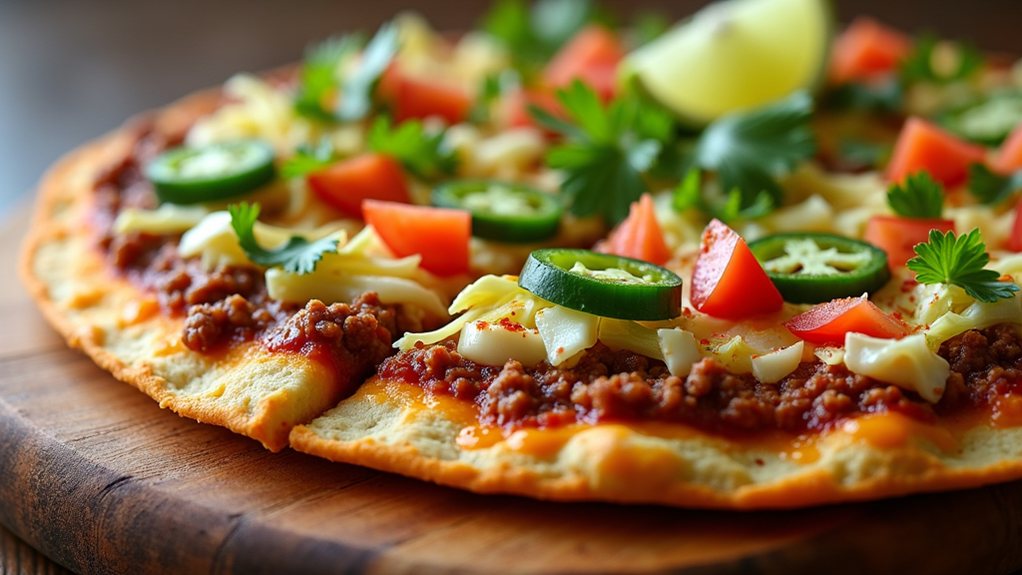
The foundation of any exceptional Mexican pizza begins with a perfectly crisp tortilla base, which provides the structural integrity and satisfying crunch that distinguishes this fusion creation from its traditional Italian counterpart.
Large flour tortillas, particularly those restaurant-grade varieties from brands like Old El Paso, offer the ideal canvas for building your masterpiece.
For best results, preheat your oven to 400°F, place tortillas on a baking sheet, and pierce them with a fork to prevent unwanted puffing.
Bake for 3-4 minutes until slightly golden before adding toppings. Those seeking extra crispiness might consider the cast iron skillet method, where tortillas cooked over medium-high heat with a touch of oil develop beautiful golden-brown edges.
This approach not only improves crispiness but also reduces cooking time, creating a sturdy foundation that remains crisp even when loaded with toppings. Unlike traditional pizza methods, avoid using a baking stone as it requires lengthy preheating and complicates cleanup when cheese inevitably spills over.
Pre-cutting your tortillas before adding toppings can help achieve uniform portions while making serving easier after cooking is complete.
Balancing Heat: Spice Levels for Every Palate
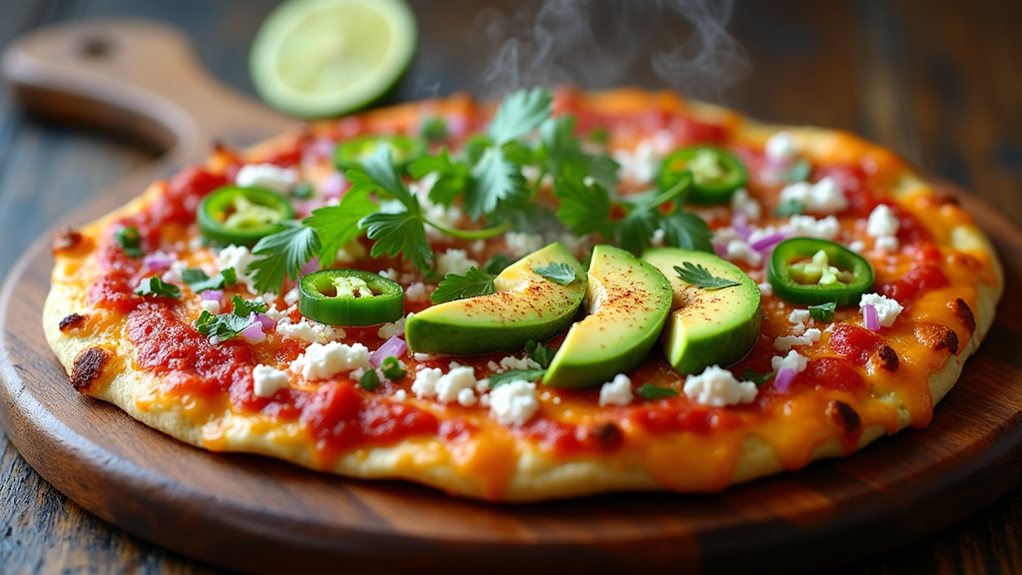
Now that your tortilla foundation is perfectly crisped, assembling a Mexican pizza that pleases everyone's palate requires thoughtful consideration of heat levels. The beauty of this dish lies in its adaptability to varying spice preferences.
For those who enjoy milder flavors, paprika and garlic powder provide depth without intensity, while oregano contributes subtle earthiness.
Moderate heat enthusiasts might appreciate taco seasoning blends or green chilies, which deliver balanced warmth without overwhelming the senses. Adventurous diners can incorporate sliced jalapeños, serranos, or a drizzle of hot sauce to enhance the experience.
Cultural traditions offer valuable guidance, as Mexican cuisine expertly balances heat with cooling elements like avocado or sour cream.
Creative Protein Options Beyond Ground Beef

Exploring protein options beyond traditional ground beef opens a world of flavor possibilities for Mexican pizza enthusiasts.
Lean alternatives like chicken breast and turkey taco meat offer similar textures with improved nutritional profiles, while seafood choices including shrimp, tuna, and crab meat create unexpected coastal variations.
For vegetarians and vegans, black beans, chickpeas, and lentils provide substantial protein without sacrificing flavor, with specialized alternatives like Quorn and seitan mimicking meat textures convincingly.
Adventurous cooks might experiment with venison, bison, or lamb for distinctive taste experiences, or enhance their creations with chorizo's spicy punch or slow-cooked pork carnitas.
When selecting proteins, consider both nutritional aspects—calories, saturated fat, sodium levels—and culinary harmony with traditional Mexican seasonings and toppings.
Layering Techniques for Maximum Flavor Impact
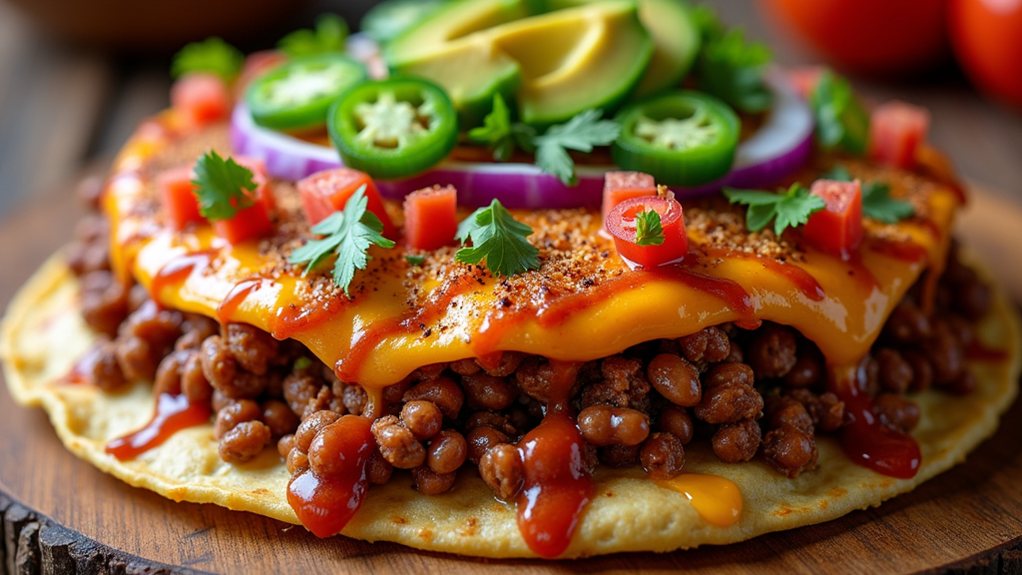
Crafting a perfect Mexican pizza relies greatly on mastering strategic layering techniques that build complexity and depth with each component. The process typically begins with a tortilla foundation—either corn or flour—which can be pre-baked or fried to improve its structural integrity and texture.
Next comes the vital flavor base: refried beans spread evenly across the tortilla, followed by seasoned ground beef or alternative proteins. Between the two tortillas, sauces like enchilada or taco sauce create a moisture barrier while contributing signature flavors. The combination can be improved by simmering seasonings with water or broth for better distribution.
Cheese plays multiple roles, appearing between layers and on top, with blends of Cheddar, Colby Jack, or Monterey Jack melting beautifully during cooking.
Whether baked, air-fried, or pan-fried, gentle pressure on the assembled layers guarantees they bond together for that perfect bite.
Fresh Toppings That Elevate Your Mexican Pizza
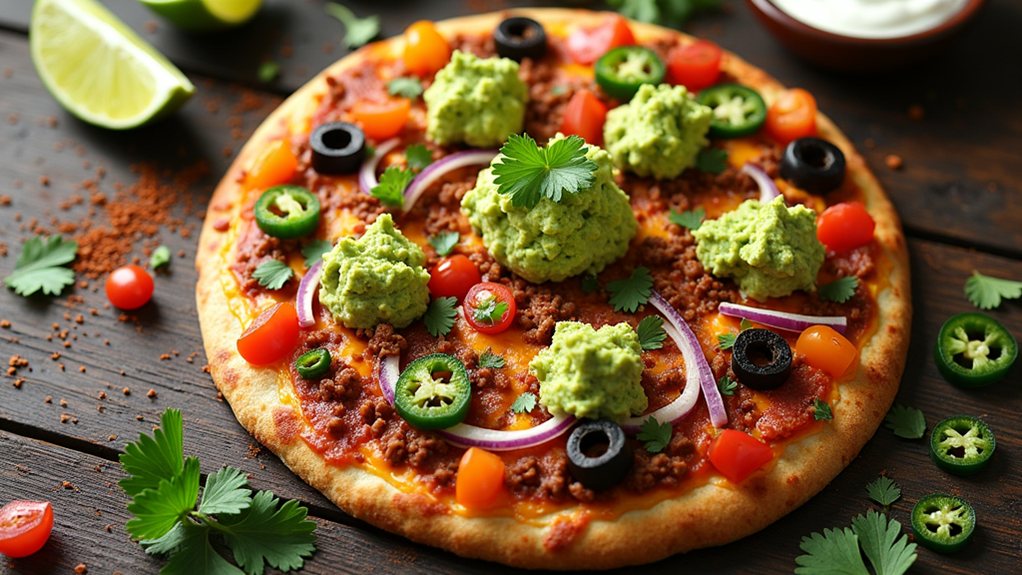
The final layer of any authentic Mexican pizza lies in its fresh toppings, which transform a good dish into an extraordinary culinary experience. Traditional options like diced tomatoes, red onion, and sour cream provide a cooling contrast to spicier elements, while black olives contribute a savory depth that complements the base flavors.
For those seeking bolder profiles, jalapeños and cayenne peppers deliver heat that can be tempered with creamy guacamole or sliced avocados.
Creative cooks might experiment with fusion toppings like Korean BBQ beef or crispy plantains, bringing unexpected dimensions to this versatile dish. Freshly made pico de gallo or corn salsa adds brightness, while a perfectly fried egg creates a luxurious finish that turns everyday Mexican pizza into a weekend indulgence.
Healthier Twists on the Classic Recipe
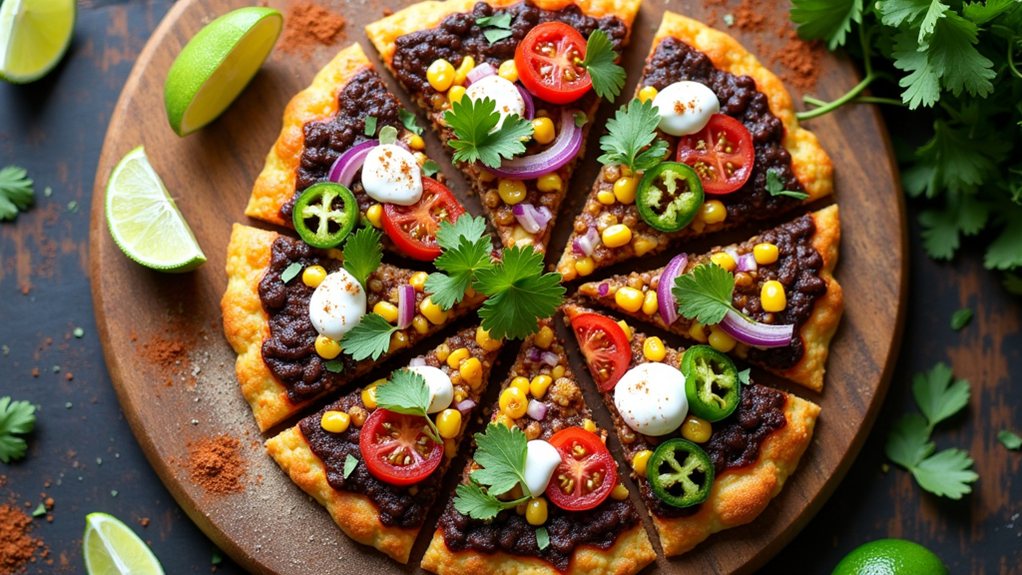
Health-conscious food enthusiasts can enjoy Mexican pizza without sacrificing flavor or nutritional value through several thoughtful modifications to the classic recipe.
Substituting traditional crusts with whole grain alternatives, cauliflower bases, or even portobello mushroom caps dramatically increases fiber while reducing refined carbohydrates.
Refried black beans serve as a protein-rich alternative to conventional tomato sauce, while part-skim mozzarella delivers flavor with fewer calories.
Fresh veggies like bell peppers not only add crucial vitamins but also bring vibrant color and texture to each slice.
For those seeking additional protein, grilled chicken strips, shrimp, or plant-based options like lentils create satisfying variations.
Homemade salsas and Greek yogurt-based sauces replace higher-calorie condiments, while aromatic herbs like cilantro and metabolism-boosting spices such as chili powder improve flavor profiles without extra calories.
Serving Suggestions and Complementary Side Dishes

Elevating the Mexican pizza experience extends well beyond the pie itself to include thoughtfully paired sides, beverages, and presentation elements that create a complete culinary adventure.
Complementary dishes improve the meal's flavor profile while providing textural contrast to the crispy-meets-cheesy pizza base.
For a well-rounded Mexican dining experience, consider these thoughtful additions:
- Fresh dipping options like guacamole or pineapple pico de gallo that cut through the richness of the cheese.
- Light accompaniments such as a simple green salad or tangy slaw that balance the heartier pizza flavors.
- Beverage pairings including aguas frescas, sparkling water with lime, or for adults, a crisp white wine or Mexican beer.
Garnishing with fresh cilantro or green onions adds a final touch of color and herbaceous flavor that transforms a casual meal into a vibrant feast.
Regional Variations of Mexican Pizza Across North America
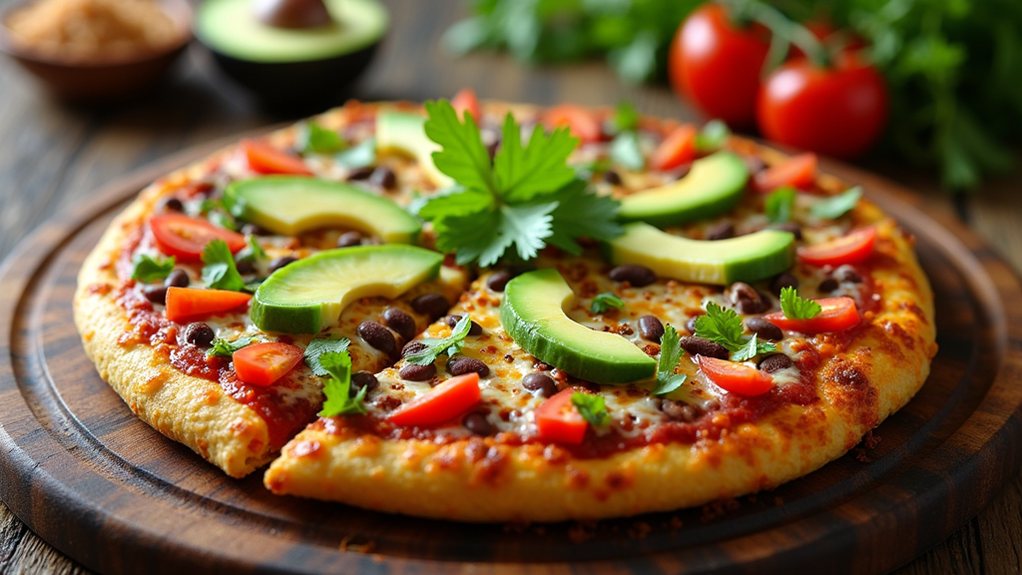
Across the varied landscapes of North America, Mexican pizza has evolved into a fascinating culinary tapestry that reflects both regional preferences and cultural blending.
In California, pizzerias often feature chicken and barbecue sauce alongside traditional Mexican ingredients, while Southwestern states incorporate grilled meats and robust spices influenced by Northern Mexico.
Border states like Texas and Arizona, due to their proximity to Mexico, showcase more authentic Mexican flavors in their pizza creations.
The authentic spirit of Mexico infuses pizza creations in Texas and Arizona, where geographical proximity breeds culinary authenticity.
Meanwhile, New York City's diverse culinary scene offers multiple Mexican-inspired pizzas, though they aren't as widespread as other regional styles.
These variations typically substitute traditional tomato sauce with refried beans or taco sauce, and may replace mozzarella with Oaxaca or pepper jack cheese.
This adaptability makes Mexican pizza a versatile choice for both casual gatherings and cultural celebrations.
FAQs
Can Mexican Pizza Be Frozen and Reheated Successfully?
Mexican pizza can be frozen for 2-3 months and successfully reheated using different methods. Proper wrapping prevents freezer burn, while reheating in an oven or air fryer restores its crispy texture.
What Alternative Tortilla Options Work for Gluten-Sensitive Individuals?
Gluten-sensitive individuals can enjoy corn tortillas, certified gluten-free flour tortillas, rice wraps, or specialty gluten-free crusts like Udi's. Double-layering corn tortillas provides better structural support for toppings.
How Long Does Homemade Enchilada Sauce Stay Fresh?
Homemade enchilada sauce remains fresh for 3-5 days when refrigerated properly in airtight containers. For extended preservation, freezing can maintain quality for up to 3 months when stored in portioned containers.
Can Mexican Pizza Be Prepared in Advance for Parties?
Yes, Mexican pizzas can be prepared in advance for parties. Components like taco meat, beans, and tortillas can be prepped separately, then assembled and reheated when needed for convenient entertaining.
Are There Keto-Friendly Adaptations for Mexican Pizza?
Yes, keto-friendly Mexican pizzas exist using alternative crusts like cheese-based or almond flour tortillas, topped with seasoned meat, cheese, and low-carb vegetables while maintaining authentic flavors.
